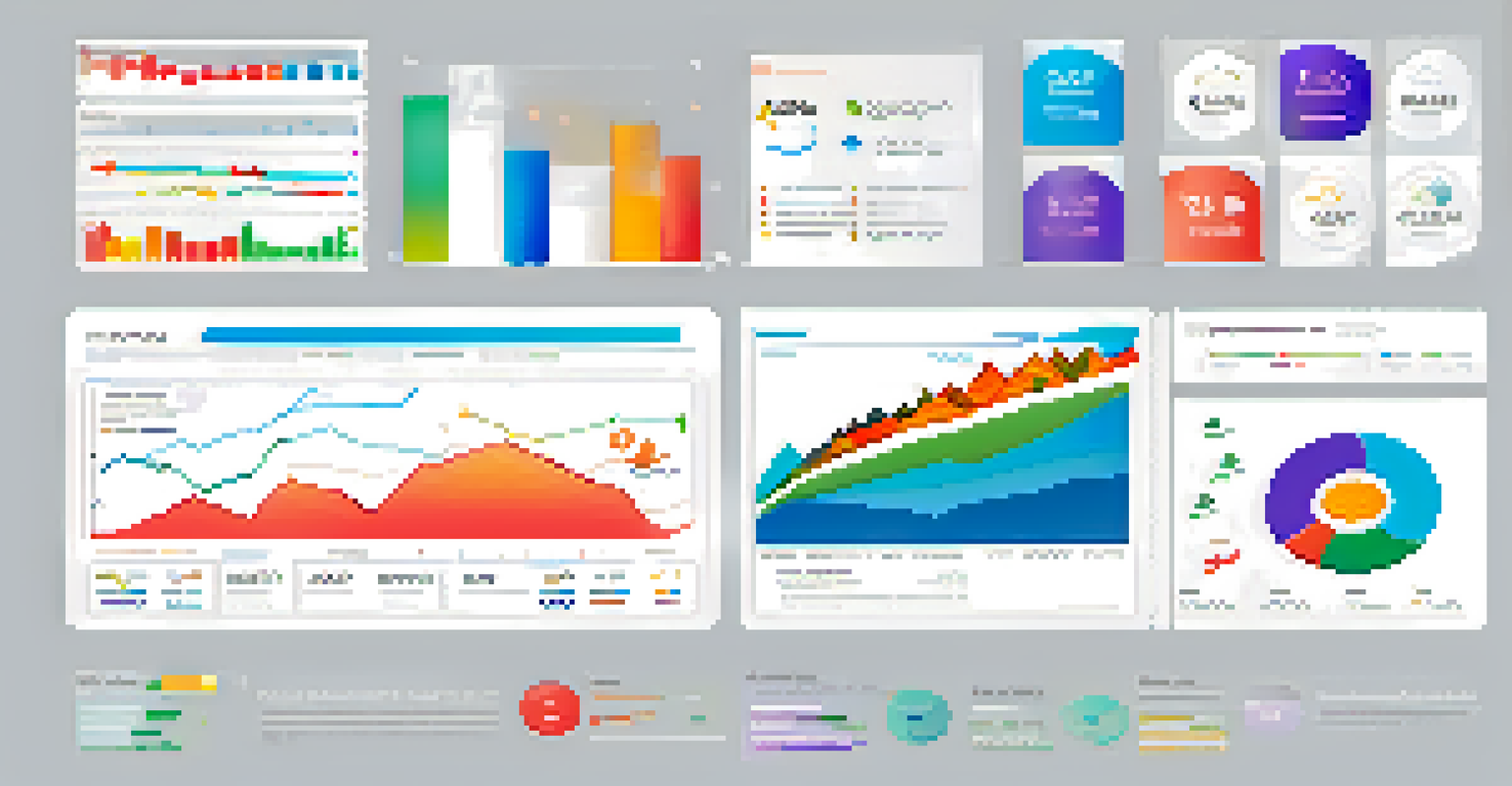SaaS Metrics: Key Performance Indicators to Track Success

Understanding SaaS Metrics and Their Importance
SaaS metrics are essential for evaluating the health and performance of your software as a service business. They provide insights into customer behavior, revenue generation, and operational efficiency. By tracking these metrics, you can make informed decisions that drive growth and improve customer satisfaction.
What gets measured gets managed.
Different from traditional metrics, SaaS metrics focus on subscription-based models, which require different strategies for success. For instance, understanding churn rate is crucial, as it directly impacts your recurring revenue. By keeping a close eye on these numbers, you can identify areas for improvement and optimize your offerings.
Ultimately, a solid grasp of SaaS metrics allows you to align your business goals with customer needs, ensuring a win-win situation. As you dive deeper into this topic, you’ll discover that these metrics are not just numbers; they tell the story of your business’s journey.
Monthly Recurring Revenue (MRR): The Backbone of SaaS
Monthly Recurring Revenue, or MRR, is a critical metric for any SaaS business, as it reflects the predictable revenue you can expect each month. Unlike one-time sales, MRR gives you a clearer picture of your financial health and growth trajectory. This consistency allows for better budgeting and forecasting.

To calculate MRR, simply multiply the total number of subscribers by the average revenue per user (ARPU). For example, if you have 100 subscribers paying $50 monthly, your MRR is $5,000. Keeping track of MRR helps you understand the impact of customer acquisition and retention efforts on your bottom line.
Key SaaS Metrics Drive Growth
Understanding and tracking SaaS metrics like MRR, churn rate, and CAC helps businesses make informed decisions that enhance customer satisfaction and drive growth.
As your business scales, tracking MRR becomes even more vital. It highlights trends over time, helping you identify potential issues early and make strategic adjustments to your pricing or marketing strategies.
Churn Rate: Understanding Customer Retention
Churn rate is the percentage of customers who cancel their subscriptions within a given period. High churn rates can be detrimental to your growth, as they indicate dissatisfaction or unmet needs among your users. By understanding churn, you can implement strategies to improve customer retention.
Data beats emotions.
To calculate churn rate, divide the number of customers lost during a month by the total number of customers at the start of that month. For example, if you start with 200 customers and lose 10, your churn rate is 5%. Keeping this number low is essential for maintaining a healthy MRR.
Addressing churn involves understanding why customers leave and taking proactive steps to enhance their experience. This may include improving customer support, offering better onboarding processes, or gathering feedback to refine your product.
Customer Acquisition Cost (CAC): Know Your Spending
Customer Acquisition Cost, or CAC, measures how much you spend to acquire a new customer. This metric is crucial, as it directly impacts your profitability. A high CAC can signal inefficiencies in your marketing or sales strategies, while a low CAC indicates a more effective approach.
To calculate CAC, divide your total sales and marketing expenses by the number of new customers acquired during that period. For instance, if you spent $10,000 and gained 100 new customers, your CAC would be $100. Knowing your CAC helps you balance spending with revenue generation.
MRR and Churn Rate Impact Profit
Monitoring Monthly Recurring Revenue (MRR) and churn rate is essential for maintaining financial health and ensuring customer retention in a subscription-based model.
A well-managed CAC allows for sustainable growth, enabling you to invest in scaling your business without overspending. By continually analyzing and optimizing your acquisition strategies, you can improve this metric and boost your overall profitability.
Lifetime Value (LTV): Measuring Long-Term Profitability
Lifetime Value, or LTV, estimates the total revenue you can expect from a customer throughout their subscription period. This metric helps you understand the long-term value of acquiring new customers and is essential for strategic planning. A high LTV indicates that customers are loyal and contributing significantly to your revenue.
To calculate LTV, you can multiply the average revenue per user (ARPU) by the average customer lifespan. For example, if your ARPU is $50 and customers typically stay for 24 months, your LTV would be $1,200. This insight allows you to make informed decisions about how much to invest in acquiring new customers.
Understanding LTV also helps you assess the effectiveness of your customer retention strategies. If your LTV is high but your CAC is also high, you may need to rethink your acquisition strategies to ensure long-term profitability.
Net Promoter Score (NPS): Gauging Customer Satisfaction
Net Promoter Score (NPS) is a straightforward yet powerful metric that measures customer loyalty and satisfaction. It’s based on a single question: 'On a scale from 0 to 10, how likely are you to recommend our service to a friend?' This question helps you gauge how customers feel about your brand.
After collecting responses, categorize them into promoters (9-10), passives (7-8), and detractors (0-6). Your NPS is calculated by subtracting the percentage of detractors from the percentage of promoters. A high NPS indicates strong customer loyalty, while a low score suggests areas for improvement.
Customer Satisfaction Matters
Utilizing metrics like Net Promoter Score (NPS) allows businesses to gauge customer satisfaction and loyalty, guiding improvements in products and services.
Tracking NPS over time helps you identify trends and the impact of changes in your product or service. By actively addressing customer feedback, you can enhance satisfaction and foster a loyal customer base.
Conversion Rate: Turning Leads into Customers
Conversion rate measures the percentage of visitors who complete a desired action on your website, such as signing up for a free trial or making a purchase. This metric is crucial for understanding the effectiveness of your marketing efforts and optimizing your sales funnel. A higher conversion rate means more leads are turning into paying customers.
To calculate your conversion rate, divide the number of conversions by the total number of visitors and multiply by 100. For example, if you had 1,000 visitors and 50 converted, your conversion rate would be 5%. Analyzing this metric helps you identify bottlenecks in the customer journey.

Improving your conversion rate might involve A/B testing different landing pages, refining your messaging, or enhancing your call-to-action strategies. Small changes can lead to significant increases in conversions and overall business success.
Why Tracking These Metrics is Essential for Growth
Tracking SaaS metrics is not just about numbers; it’s about understanding your business and driving growth. By regularly monitoring these key performance indicators, you can make data-driven decisions that align with your goals. This proactive approach allows for continuous improvement and adaptation in a competitive landscape.
Moreover, these metrics provide valuable insights into your customers’ needs and behaviors. By analyzing trends and patterns, you can tailor your offerings and marketing strategies to better serve your audience. This customer-centric focus ultimately leads to increased satisfaction and loyalty.
In essence, embracing SaaS metrics empowers you to take control of your business’s future. By leveraging data, you can navigate challenges, seize opportunities, and foster sustainable growth that benefits both your company and your customers.